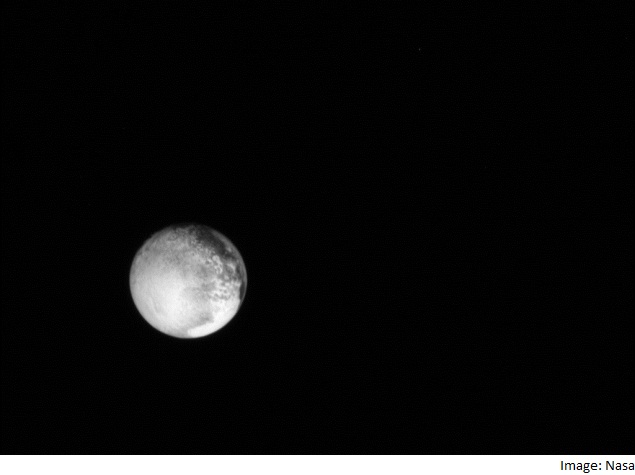- Home
- Science
- Science News
- Nasa's New Horizons Probe Flies Past Pluto, World Awaits Historic Images
Nasa's New Horizons Probe Flies Past Pluto, World Awaits Historic Images

Crossing Pluto from a distance of about 12,500km at around 5.19pm IST (Indian standard Time), the mission is expected to beam back key images of Pluto's surface to Earth in about nine hours - the time it takes the communication to reach Earth from Pluto.
The images will also help scientists explore the mysterious Kuiper Belt.
It is a huge band of planetary debris left over from the solar system's formation 4.5 billion years ago.
The most dangerous hazards for the probe are dust particles trapped in orbit around Pluto and a strike can hit the spacecraft, scientists said, but added that such a risk is very low.
The first images will be debut on Facebook-owned photo-sharing website Instagram, Nasa has announced.
"We made an editorial decision to give the world a sneak peek of the image on Instagram," Nasa social media manager John Yembrick told wired.com.
On board the New Horizons are seven sophisticated science instruments and the ashes of Clyde Tombaugh, the astronomer who discovered Pluto in 1930.
Nasa was expecting a dark grey icy planet but the probe found it is red and appeared to be oxidised like Mars.
Earlier, the New Horizons probe settled one of the most basic questions about Pluto - its size. Mission scientists have found Pluto to be 2,370km in diameter, somewhat larger than many prior estimates.
Images acquired with the Long Range Reconnaissance Imager (Lorri) on board the New Horizon probe were used to make this determination.
The result confirms that Pluto is larger than all other known solar system objects beyond the orbit of Neptune, the US space agency said in a statement.
"The size of Pluto has been debated since its discovery in 1930. We are excited to finally lay this question to rest," said mission scientist Bill McKinnon from Washington University in St Louis.
Pluto's newly estimated size means that its density is slightly lower than previously thought, and the fraction of ice in its interior is slightly higher.
Measuring Pluto's size has been a decades-long challenge due to complicating factors from its atmosphere.
Its largest moon Charon lacks a substantial atmosphere, and its diameter was easier to determine using ground-based telescopes.
New Horizons observations of Charon confirm its previous estimated size of 1,208km across.
Two other moons - Nix and Hydra - were discovered using the Hubble Space Telescope in 2005.
Nix is estimated to be about 35km across while Hydra is roughly 45km across.
These sizes lead mission scientists to conclude that their surfaces are quite bright, possibly due to the presence of ice.
Pluto's two smallest moons, Kerberos and Styx, are smaller and fainter than Nix and Hydra and are harder to measure, the US space agency said.
Catch the latest from the Consumer Electronics Show on Gadgets 360, at our CES 2026 hub.
Related Stories
- Samsung Galaxy Unpacked 2025
- ChatGPT
- Redmi Note 14 Pro+
- iPhone 16
- Apple Vision Pro
- Oneplus 12
- OnePlus Nord CE 3 Lite 5G
- iPhone 13
- Xiaomi 14 Pro
- Oppo Find N3
- Tecno Spark Go (2023)
- Realme V30
- Best Phones Under 25000
- Samsung Galaxy S24 Series
- Cryptocurrency
- iQoo 12
- Samsung Galaxy S24 Ultra
- Giottus
- Samsung Galaxy Z Flip 5
- Apple 'Scary Fast'
- Housefull 5
- GoPro Hero 12 Black Review
- Invincible Season 2
- JioGlass
- HD Ready TV
- Laptop Under 50000
- Smartwatch Under 10000
- Latest Mobile Phones
- Compare Phones
- OPPO Reno 15 FS
- Red Magic 11 Air
- Honor Magic 8 RSR Porsche Design
- Honor Magic 8 Pro Air
- Infinix Note Edge
- Lava Blaze Duo 3
- Tecno Spark Go 3
- iQOO Z11 Turbo
- Lenovo Yoga Slim 7x (2025)
- Lenovo Yoga Slim 7a
- Lenovo Idea Tab Plus
- Realme Pad 3
- Moto Watch
- Garmin Quatix 8 Pro
- Haier H5E Series
- Acerpure Nitro Z Series 100-inch QLED TV
- Asus ROG Ally
- Nintendo Switch Lite
- Haier 1.6 Ton 5 Star Inverter Split AC (HSU19G-MZAID5BN-INV)
- Haier 1.6 Ton 5 Star Inverter Split AC (HSU19G-MZAIM5BN-INV)







![[Sponsored] Haier C90 OLED TV | Dolby Vision IQ, 144Hz OLED and Google TV in Action](https://www.gadgets360.com/static/mobile/images/spacer.png)









